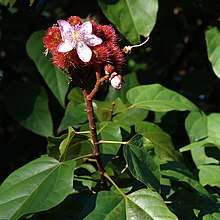Bixa
Bixa is a genus of plants in the family Bixaceae. It is native to Mexico, Central America, Caribbean, and South America, and naturalized in other places.[1][2][3][4]
| Bixa | |
|---|---|
 | |
| Leaves, flower and fruits of Bixa orellana. | |
| Scientific classification | |
| Kingdom: | Plantae |
| Clade: | Tracheophytes |
| Clade: | Angiosperms |
| Clade: | Eudicots |
| Clade: | Rosids |
| Order: | Malvales |
| Family: | Bixaceae |
| Genus: | Bixa L. |
| Synonyms[1] | |
| |
Species
The genus includes the following species:[1]
- Bixa arborea Huber - Brazil, Ecuador, Peru
- Bixa excelsa Gleason & Krukoff - Peru, northwestern Brazil
- Bixa orellana L. - widespread from Mexico to Argentina; naturalized in West Indies, parts of Africa, India, Sri Lanka, the Philippines, Christmas Island, Hawaii, Society Islands
- Bixa platycarpa Ruiz & Pav. ex G.Don - Ecuador, Peru, northwestern Brazil
- Bixa urucurana Willd. - Honduras, Panama, Colombia, Venezuela, the Guianas, Ecuador, Peru, northwestern Brazil
gollark: In that case, can't, I'm on survival multiplayer.
gollark: Does it work on nonadvanced computrons?
gollark: Oh, cool.
gollark: *Is* it deprecated?
gollark: Hmm. Have you tried using jQuery?
References
- Kew World Checklist of Selected Plant Families
- Forzza, R. C. 2010. Lista de espécies Flora do Brasil "Archived copy". Archived from the original on 2015-09-06. Retrieved 2015-08-20.CS1 maint: archived copy as title (link). Jardim Botânico do Rio de Janeiro, Rio de Janeiro
- Idárraga-Piedrahita, A., R. D. C. Ortiz, R. Callejas Posada & M. Merello. (eds.) 2011. Flora de Antioquia: Catálogo de las Plantas Vasculares 2: 9–939. Universidad de Antioquia, Medellín
- Molina Rosito, A. 1975. Enumeración de las plantas de Honduras. Ceiba 19(1): 1–118.
This article is issued from Wikipedia. The text is licensed under Creative Commons - Attribution - Sharealike. Additional terms may apply for the media files.